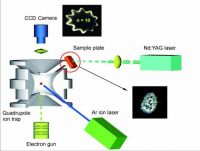Mass spectrometer is one of the most important analytical tools in modern technology. It is widely used in research as well as manufacturing processes to identify major chemical components of most materials. It has become one of the most critical tools for biomedical research, disease diagnosis, ecology research, environmental protection, geological survey and oil exploration. Therefore, when researchers from Academia Sinica reported their success in developing this special novel mass spectrometer for bacteria and cancer cell measurements, it aroused lots of attention among international scientific communities immediately. Experimental results were lately published in one of the top chemistry journals, namely Angew Chem. Inter. (W. P. Peng, Y. C. Yang, M. W. Kang, Y. K. Tzeng, Z. Nie, H. C. Chang, W. Chang and C. H. Chen; “Laser-Induced Acoustic Desorption Mass Spectrometry of Single Bioparticles”; Angew. Chem. Int. Ed. 45, 1423-1426 (2006)) This paper has been recognized as one of the top 5% of papers published in this journal.

This important interdisciplinary research was initiated and pursued by Dr. Huan-Cheng Chang of Institute of Atomic & Molecular Sciences and Dr. Chung-Hsuan Chen of Genomics Research Center. The novel mass spectrometer they developed can trap cells or nano/micro particles in an ion trap device by a laser-induced acoustic desorption processes. The masses of these trapped cells or particles can subsequently be determined.
This newly developed technology is eye catching because it creates mass spectrometer with three unique features that out perform any currently available equipment. First of all, the mass range measured can be more than 1012 Daltons while other mass spectrometers are limited to be less than 106 Daltons. In other words, this is the only instrument to be able to measure the masses of a single cancer cell or a microparticle.
Secondly, a “Laser-Induced acoustic desorption” technique was used to achieve soft desorption so that a cell can be desorbed from a surface for mass determination without any possible damage to the cell.
Lastly, it requires least lab procedures. Conventional methods require “ionization”, which is an essential but difficult step especially for large biomolecules or particles to do mass determination. This research team found that most micro/nano particles including cells having charges attached during the laser-induced acoustic desorption process so that ionization is not needed.
Not only multinational patents have been filed for this research discovery, the Genomics Research Center of Academia Sinica also has high interest in transferring this technology through its incubation center. Observers believe this could lead to a brand new industry in Taiwan.

